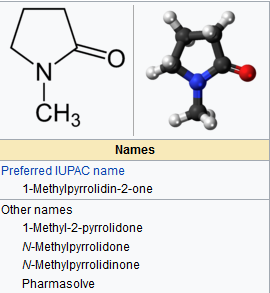N-Methylpyrrolidone is a chemical compound that has a molecular weight of 99.133 grams per mole. As such, it is heavier than water. It can also be identified as N-methyl-2-pyrrolidone or 1-methyl-2-pyrrolidone. However, its common name is methyl pyrrolidone. This compound exists in a colorless liquid form with an odor similar to the once associated with fish. Methylpyrrolidone’s boiling point stands at 199 degrees Fahrenheit. Methyl pyrrolidone is organic in nature and it contains 5 carbon rings with one of them having a nitrogen atom attached. This aspect explains the compound’s molecular formula, which is C5H9NO.

Common Products Containing Methylpyrrolidone
NMP serves as the primary component in several kinds of paint as well as coating removers that are marketed in different regions across the world. Apart from being found on paint strippers, the compound is also present in various coating materials that are sold by some common retailers in this market. Lastly, it is used in the manufacture of commodities such as glues, soaps, colorants, inks, as well as insecticides.
Exposure to NMP
If released into the environment, Methylpyrrolidone occurs as vapor. In the atmosphere, this compound undergoes condensation. Nonetheless, Methylpyrrolidone has reduced vapor pressure, an aspect that minimizes its capacity to be inhaled. On the other hand, if NMP is mixed with water, it does not form bonds with suspended solids or readily evaporates due to the fact that it possesses reduced vapor pressure. For this reason, NMP is considered highly mobile when it is poured on the soil. Furthermore, it is likely to evaporate at a slow rate from soils surfaces. Alternatively, its high mobility implies that it is likely to move through the soil and cause contamination to groundwater.
If the compound is released into the atmosphere, bacteria represent its primary decomposers, although other living organisms are also likely to facilitate this process. Therefore, Methylpyrrolidone does not aggregate into significant amounts in the air.
For human beings, exposure to this compound occurs primarily through either inhalation or skin exposure to its liquid and vapor forms. Alternatively, people may be exposed to NMP through ingesting vapor that is deposited on the nose, mouth, and throat if the compound is present in the environment. The most vulnerable populations are individuals who work in industries that manufacture products that use NMP as the main ingredients. On the other hand, occupational non-users may come into contact with Methylpyrrolidone through handling products containing NMP such as paints, soaps, as well as children’s toys.
Health Effects of Methylpyrrolidone
In humans, exposure to this compound takes place through inhalation, the mouth, or the skin. Based on studies conducted in this area, distribution of NMP in the body follows once it has been absorbed and it undergoes metabolism, which reduces it to water-soluble compounds.
The metabolized compounds are released from the body in urine within a day. Methyl pyrrolidone is similar to other chemicals in that its poisonous properties are determined by the level to which an individual is exposed, as well as the duration. Although empirical research inquiries have not identified reasonable complicating factors once NMP is absorbed in the human body, it has been established that it may be poisonous to the fetus. In test animals, Methylpyrrolidone was found to have low toxicity after exposure to high levels over a short period.